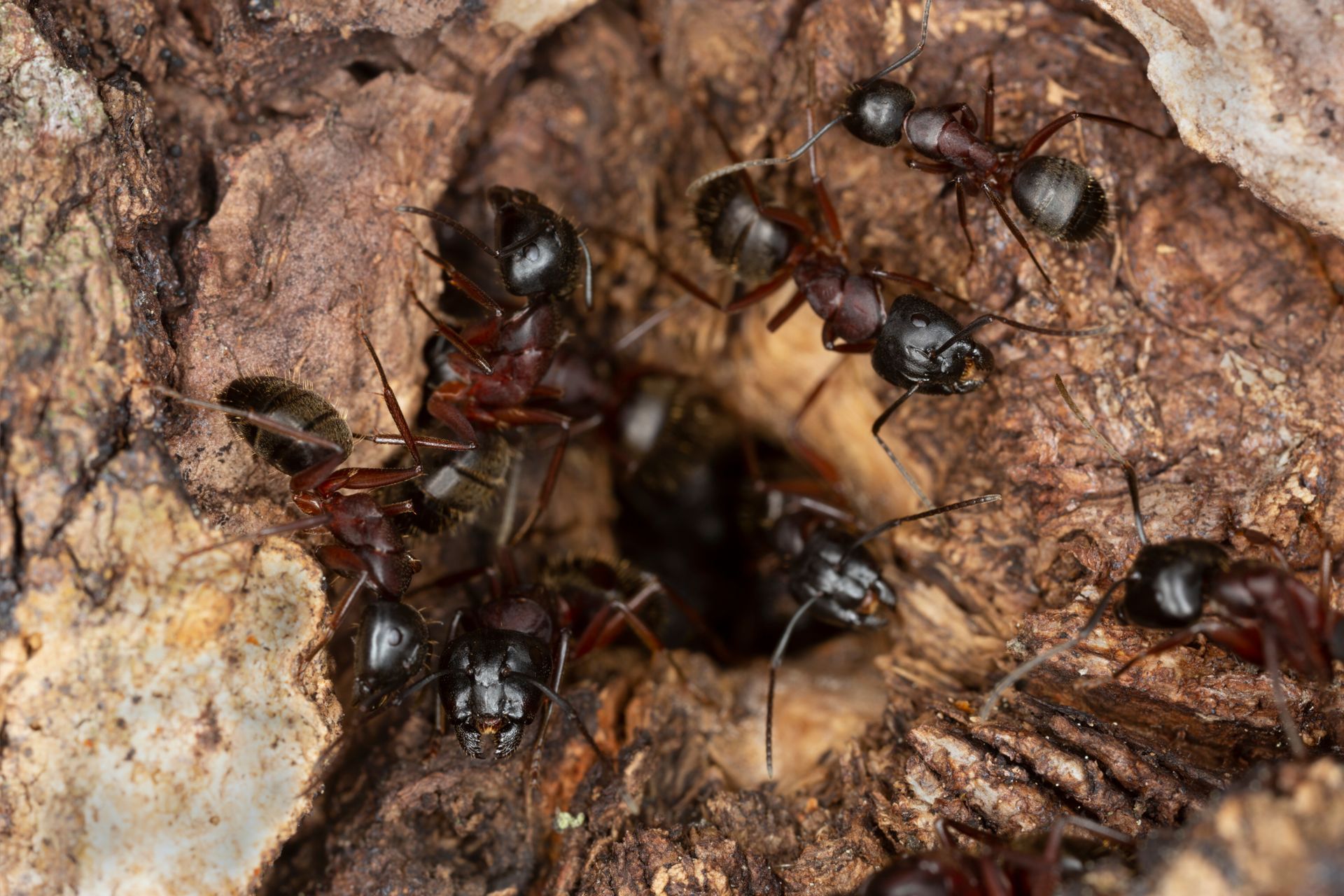Tree Infested With Ants

Trees infested with ants may have damaged bark, weak branches, and ugly blemishes. An ant infestation can also cause the tree to become unstable and unable to support itself. We cover everything you need to know about a tree infested with ants below.
Table of Contents
Ants are remarkable creatures. They have an incredible ability to organize societies. And they can thrive in tons of different environments. One of these environments is trees. And sometimes, that means an infestation.
Why Trees Get Infested With Ants
Ants go into trees for a few different reasons:
- Nutrition
- Shelter
- Forming Satellite Colonies
- Safe Passage
The type of ant species that infests a tree will determine the extent of the damage. Carpenter ants are the most common type of ant infesting trees. They excavate holes in the tree which when filled with moisture can weaken the tree's structure.
Nutrition & Aphids
Aphids are small, soft-bodied insects. They feed on plants and produce a sugary liquid called honeydew. Aphids often feed in and on trees.
Ants are attracted to this sticky, sweet substance because they feed on it. Trees with large populations of aphids will have excessive carpenter ant activity.
But aphids aren't the only insects that produce this substance. There's also scale, mealybugs, and whiteflies.
Seeking Shelter
Carpenter ants seek shelter in trees. They can excavate holes in the wood to form nesting sites. Their nesting sites are a key signal of an infestation. An excessive amount of carpenter ant nesting sites can hollow out a tree, weakening it's structure.
Did You Know? A carpenter ant nest cavity might contain the whole colony, which has up to 3,000 adult ants.
Satellite Colonies
Carpenter ants also form satellite colonies in trees. These satellite colonies are full of ants that collect extra food for new larvae. Again, these colonies are formed in tree cavities since they provide a secure place for the eggs to hatch and grow.
Safe Passage
Some ants use tree cavities to travel from their nest to their food source. They go up and down a tree's branches and trunk to access food, such as dead insects or sap.
Since these ants leave a pheromone trail behind, they attract other ants to the same tree. Large populations of ants drawn walking through the same tree could mean infestation.
If any aphids start feeding on the tree, the ants could be drawn to the honeydew and infest the tree.
How Ant Infestation Affects Tree Health
The presence of carpenter ants does not necessarily indicate a threat to the tree's health. But ants can indirectly harm a tree in some ways:
- Nurturing Harmful Insects
- Direct Damage to the Wood Or Bark
- Rotting Wood
Nurturing Harmful Insects
Ants may protect and nurture sap-sucking insects, like scale insects and aphids. If these insects are abundant, they may feed excessively on the tree's sap, weakening it over time.
Direct Damage to the Wood
Some ants, such as red imported fire ants, can harm trees directly. They tunnel in the surrounding soil, reducing compaction and exposing roots to the air. Excessive air exposure dries out the roots, stunting growth in young and tender trees.
Fire ants also form dome-shaped mounds at the base of the tree. If you see these structures, do not disturb or touch them since these ants can sting you. We cover same ways how to eradicate ants below.
Rotting Wood
While a carpenter ant nest or infestation doesn't cause wood rotting, check for rotting wood if you have an infestation. Their homes in the tree could lead to excess moisture buildup in the tree. If you notice a carpenter ant infestation in a tree, check it for signs of rot, such as discoloration or a foul smell.
Carpenter Tree Ant Infestation
Carpenter ants are the most common ant species to infest trees. These are big black ants that are necessary for the ecosystem. These ants' nests comprise chambers and tunnels extending into soft wood.
These hollow spaces and openings are part of the natural decay of trees. Carpenter ants are natural recyclers that help keep the environment clean.
Claiming Their Home
When they infest a tree, they do not eat wood. Instead, they form 'galleries' in rotten wood to build their nests. That's why you'll find old insect tunnels in instances of wood decay.
Unlike termites that feed on wood, carpenter ants excavate wood bits. If you have carpenter ants, you'll see sawdust at the base of a tree. They are digging out a home.
Though carpenter ants in trees won't make a huge difference to the tree's health, they might start invading nearby structures. Those structures could be your sheds, your window frames, and other parts of your house. They can even invade some smaller plants.
Note: Plugging or sealing tree cavities through which carpenter ants enter or treating tree wounds is not advised. These treatments will not prevent wood decay or infestation.
How To Get Rid of a Tree Ant Infestation
DIY Methods will only get you so far when it comes to ant or other bug infestations. We highly recommend contacting a professional arborist or pest control expert before spraying your tree with potentially harmful chemicals.
Since carpenter ants don't kill trees, you don't have to worry much about your tree's health. Just make sure the tree isn't suffering from wood decay too. However, you may want to get rid of the ants because they keep getting into your house. Four methods for getting rid of ants are:
- Natural Repellants
- Sticky Barriers
- Insecticidal Sprays
- Boric Acids
- Professionals
Natural Repellants
Natural products such as peppermint oil, diatomaceous earth and cinnamon can repel ants. You can sprinkle these substances around the base of the tree. Or, apply them directly to the branches infested by these ants.
Create a solution with a gallon of water and 30 drops of peppermint. Spray the tree with this solution and watch the ants scurry away.
Sticky Barriers
Although this method is not as effective, it can be used for spot treatment. You can apply a sticky substance, such as petroleum jelly, to the tree trunk to prevent ants from climbing the tree.
Insecticidal Sprays
Insecticidal sprays work best for bugs that kill trees, such as aphids, leafhoppers, and moths. But they're just as effective at controlling ants.
Make sure you buy a spray labeled for use on trees since some chemicals can harm the tree's bark. Read and follow the instructions carefully before applying them to your tree.
Boric Acids
Boric act baits comprise ant-killing powder mixed with a sweet substance like sugar to attract ants. Worker ants will smell this substance and carry the bait to their parent colony.
Boric acid works as a slow-acting poison, wiping out the entire parent colony and preventing the spread of carpenter ants in your trees.
Professionals
Sometimes, professional tree care is the only way to save an ant-infested tree. Get in touch with an arborist for help. They will assess the extent of the infestation and determine the best way to eliminate it.
Sweet New Earth's Final Word
Ants are a part of life so we have to learn to live with them. Honestly, most of the time we don't even think about them but if you start seeing them around the house, they might be excavating a nearby tree.
FAQs

Christina Hernandez
Christina has done most of her research on environmental science but recently has changed her focus towards sustainable forestry. She has a passion for the outdoors and wants to spread that passion to the world.
Join our community!
Join to receive guides, insights, and the latest gardening deals!
